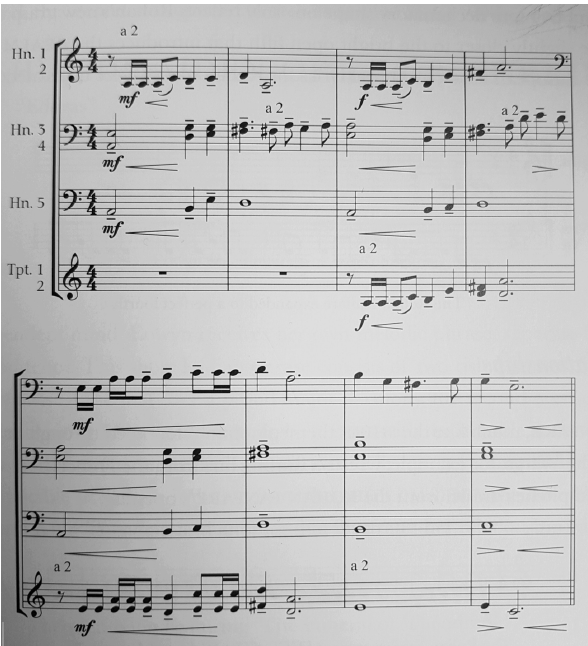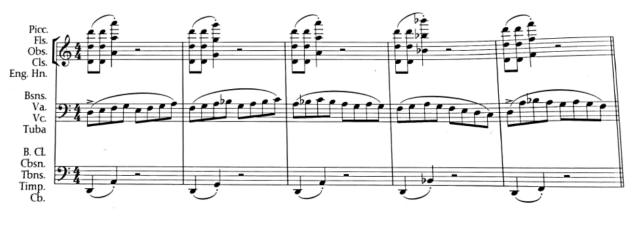“Rohan” is a pivotal location within the trilogy. It is meaningful within LR as it is portrayed as a pure human culture (without the influence of elves, etc.) and embodies core values like bravery, loyalty, and in the movies is uniquely associated with its horses. This rising of Middle-earth’s men trying to declare the world as theirs grows more violent as the movies go on, and during the sequels is brought further into focus by the application of music. It is especially in The Two Towers, that the music of this human race begins to be realized more in the music, which is largely characterized by its Nordic influences (Adams, 2011). Most Nordic folk music leans towards clearly structured melodic cells, where the motifs of the refrain are more closely related to one another than those of the verses (Ling, 2007). Moreover, Nordic influences can be characterized by repeated, interweaving phrases (Ling, 2007). Each of these techniques is used for the Rohan theme and form close similarities to the style of music and how it is formed to the Rohan culture. One can compare the music’s defining properties to Rohan art and architecture, as well as their connection to the natural world (Adams, 2011). In terms of instrumentation, a noteworthy instrument is a double fiddle, an instrument which was designed solely for the score of this movie and features eight (instead of the normal four) strings of a fiddle. This results in each string having a resonating neighbour string, and could very much be associated with a mandolin.
Variation 1: “The Rohan Fanfare” (Adams, 2011)

Here it is apparent that instrumentation wise, the “Rohan Fanfare” is performed in midrange brass, on top of that, using a harbinger fiddle – a traditional stringed instrument used originally to play cultural and traditional Nordic music (Ling, 2007) to represent the more brittle side of the Rohan cultures struggling. The use of brass can represent power, strength, and courage whilst the strings could represent their sorrow, passion, and reflection. This music then develops, as the people of Rohan move closer to Gondor, “The Realm of Gondor.” This development is apparent due to stretching the opening pitches from a minor third, to a perfect fourth (Adams, 2011). This means the new variation is now a whole tone higher than it was before:
Variation 2: “Realm of Gondor”

This variation again portrays this musky, earth-like character as it is presented in horns and strings in a low to mid-range register for the utilised instruments. Besides, it is notable that the first three pitches of this theme (A, D, C) are employed in the different variations to characterize that no matter what variation it is played in, it is of Rohan descent.
An additional variation of the Rohan theme “The Riders of Rohan” in The Two Towers is performed with several scalar runs in the low registers on the strings, as well as bassoon, concurrently with continuous upward roaring movement. This results in the music having wave-like properties. If one were to trace the notes as a visual, it can distinctly be seen that every bar, there is an upwards shift, which could be correlated with the people of Rohan striving to win, their determination, and their willpower.
Variation 3: “Riders of Rohan” (Adams, 2011)

To conclude, as we have explored with the Shire theme, likewise, the Rohan theme does an exceptional job in defining a sense of culture and place. Whilst the Shire theme is indicative of traditional Irish music, the Rohan theme succeeds in conveying in a few notes, the essentials of the Rohan culture. This is done through the use of traditional instruments, including the Hardanger fiddle, but additionally by the sense of simplicity and of honour, which the music achieves in conveying in its structure, notation, and “rich, powerful orchestration in brassy instruments” (Woodzie, 2018).
___
Works Cited
Adams, D., Walsh, F. and Shore, H. (2011). The music of The Lord of the Rings films. Van Nuys: Alfred Music Publishing Company.
Ling, J. (2007). A history of European folk music. Rochester, N.Y: University of Rochester Press.
Woodzie.org. (2018). Rohan. [online] Available at: http://www.woodzie.org/lotr/rohan.htm [Accessed 2 Apr. 2018].
